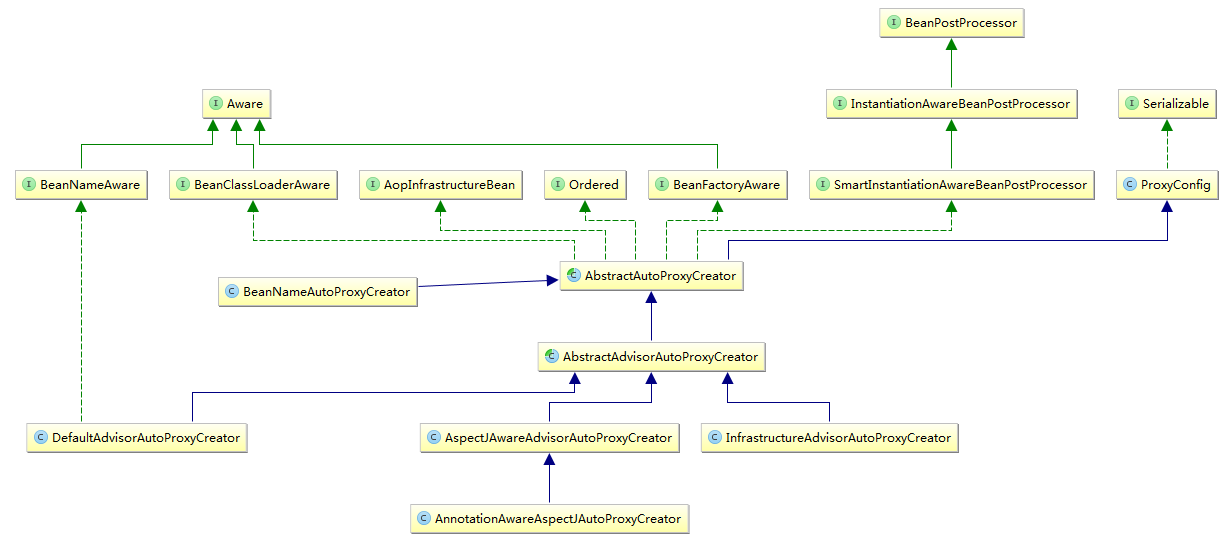死磕Spring AOP系列3:剖析Bean处理器之DefaultAdvisorAutoProxyCreator
Posted
tags:
篇首语:本文由小常识网(cha138.com)小编为大家整理,主要介绍了死磕Spring AOP系列3:剖析Bean处理器之DefaultAdvisorAutoProxyCreator相关的知识,希望对你有一定的参考价值。
导航
死磕Spring AOP系列2:剖析Bean处理器之BeanNameAutoProxyCreator
这是<死磕Spring AOP系列>的第三篇。经过前面的讲解,已经掌握了以下知识点
Spring AOP的底层支持,是基于ProxyFactory+ProxyConfig+Advisor生成的
Spring容器的代理对象生成:在Bean生命周期过长中调用BeanPostProcessor,将对象进行包装,生成代理对象。
Advisor的指定:不管编程式指定,还是自动匹配指定。虽然形式不同,但本质是相同的。
如果,还对上面的问题存疑,请回看以上内容。
本篇主要对剖析另外一个BeanPostProcessor,他就是DefaultAdvisorAutoProxyCreator,他是BeanNameAutoProxyCreator的升级版。形象点说:如果ProxyFactory是弓箭的话,代表原始,BeanNameAutoProxyCreator就是步枪,需要自己装配,DefaultAdvisorAutoProxyCreator就是自动步枪了,Spring可以完成自动匹配的部分工作了。
本章主要内容
使用DefaultAdvisorAutoProxyCreator,完成一个“AOP"例子,讲解下如何配置
对比BeanNameAutoProxyCreator,对DefaultAdvisorAutoProxyCreator进行剖析
分析DefaultAdvisorAutoProxyCreator的Advisor的匹配过程
体会自动化
1.使用DefaultAdvisorAutoProxyCreator,完成一个“AOP"例子
/**
*模拟业务接口
*/
public interface UserService {
public void updateUser();
}
/**
*模拟具体业务
*/
public class UserServiceImpl implements UserService{
@Override
public void updateUser() {
System.out.println("$$$$$$执行业务逻辑$$$$$");
}
}
/**
* 模拟切面1
*/
public class SecurityInterceptor implements MethodInterceptor {
@Override
public Object invoke(MethodInvocation methodInvocation) throws Throwable {
System.out.println("==========执行安全校验====================");
return methodInvocation.proceed();
}
}
/**
* 模拟切面2
*/
public class LoggerBeforeAdvice implements MethodBeforeAdvice {
@Override
public void before(Method method, Object[] args, Object target) throws Throwable {
System.out.println("=======保存更新日志=========");
}
}xml(proxy_test.xml)
<?xml version="1.0" encoding="UTF-8"?> <!DOCTYPE beans PUBLIC "-//SPRING//DTD BEAN 2.0//EN" "http://www.springframework.org/dtd/spring-beans-2.0.dtd"> <beans> <bean class="org.springaop.chap01.UserServiceImpl" id="userService"></bean> <bean class="org.springaop.chap01.LoggerBeforeAdvice" id="loggerBeforeAdvice"></bean> <bean class="org.springaop.chap01.SecurityInterceptor" id="securityInterceptor"></bean> <!-- 自动代理所有的advisor --> <bean class="org.springframework.aop.framework.autoproxy.DefaultAdvisorAutoProxyCreator"> <property name="usePrefix" value="true"></property> <property name="advisorBeanNamePrefix" value="advisor"></property> </bean> <bean id="advisor1" class="org.springframework.aop.support.RegexpMethodPointcutAdvisor"> <property name="pattern"> <value>.*update.*</value> <!-- 业务实现方法名匹配 --> </property> <property name="advice"> <ref bean="loggerBeforeAdvice"/> </property> </bean> <bean id="advisor2" class="org.springframework.aop.support.RegexpMethodPointcutAdvisor"> <property name="pattern"> <value>.*update.*</value> <!-- 业务实现方法名匹配 --> </property> <property name="advice"> <ref bean="securityInterceptor"/> </property> </bean> </beans>
Main
public class ContextMain {
public static void main(String[] args) {
ApplicationContext ctx = new ClassPathXmlApplicationContext("org/springaop/chap03/proxy_test.xml");
UserService userService =(UserService) ctx.getBean("userService");
// UserService userService2 =(UserService) ctx.getBean("userService2");
userService.updateUser();
// userService2.updateUser();
}
}执行结果
=======保存更新日志=========
==========执行安全校验====================
$$$$$$执行业务逻辑$$$$$
说明:usePrefix和advisorBeanNamePrefix配合使用,如果usePrefix设置为false,advisorBeanNamePrefix设置没有作用。通过上面的设置配置,advisor2和advisor都有效果。
2.剖析DefaultAdvisorAutoProxyCreator类
2.1 结构层次图
可知,DefaultAdvisorAutoProxyCreator,BeanNameAutoProxyCreator是AbstractAutoProxyCreator的子类。通过前面讲解,知道AbstractAutoProxyCreator有个抽象方法。
方法声明如下
//是否被代理?返回interceptors //Return whether the given bean is to be proxied, what additional advices (e.g. AOP Alliance interceptors) and advisors to apply. protected abstract Object[] getAdvicesAndAdvisorsForBean( Class<?> beanClass, String beanName, TargetSource customTargetSource) throws BeansException;
DefaultAdvisorAutoProxyCreator 和BeanNameAutoProxyCreator分别实现各自逻辑。BeanNameAutoProxyCreator的实现不再赘述,在死磕Spring AOP系列2已经讲过,代码很简单。
2.2 剖析getAdvicesAndAdvisorsForBean方法
public abstract class AbstractAdvisorAutoProxyCreator extends AbstractAutoProxyCreator {
...
protected Object[] getAdvicesAndAdvisorsForBean(Class beanClass, String beanName, TargetSource targetSource) {
List advisors = findEligibleAdvisors(beanClass, beanName);
if (advisors.isEmpty()) {
return DO_NOT_PROXY;
}
return advisors.toArray();
}
protected List<Advisor> findEligibleAdvisors(Class beanClass, String beanName) {
List<Advisor> candidateAdvisors = findCandidateAdvisors();//获取所有的Advisors
//获取可以应用于beanName的Advisor(逻辑尽在此)
List<Advisor> eligibleAdvisors = findAdvisorsThatCanApply(candidateAdvisors, beanClass, beanName);
extendAdvisors(eligibleAdvisors);
if (!eligibleAdvisors.isEmpty()) {
eligibleAdvisors = sortAdvisors(eligibleAdvisors);
}
return eligibleAdvisors;
}
//Find all candidate Advisors to use in auto-proxying.
protected List<Advisor> findCandidateAdvisors() {
//委托给BeanFactoryAdvisorRetrievalHelper处理
return this.advisorRetrievalHelper.findAdvisorBeans();
}
}
public class BeanFactoryAdvisorRetrievalHelper {
public List<Advisor> findAdvisorBeans() {
...
if (advisorNames == null) {
//获取容器中声明的Advisor
// Do not initialize FactoryBeans here: We need to leave all regular beans
// uninitialized to let the auto-proxy creator apply to them!
advisorNames = BeanFactoryUtils.beanNamesForTypeIncludingAncestors(
this.beanFactory, Advisor.class, true, false);
...
}
if (advisorNames.length == 0) {
return new LinkedList<Advisor>();
}
List<Advisor> advisors = new LinkedList<Advisor>();
for (String name : advisorNames) {
//判断返回
if (isEligibleBean(name) && !this.beanFactory.isCurrentlyInCreation(name)) {
try {
advisors.add(this.beanFactory.getBean(name, Advisor.class));
}
catch (BeanCreationException ex) {
...
throw ex;
}
}
}
return advisors;
}
}通过层层抽丝剥茧,定位到了AopUtils.findAdvisorsThatCanApply,负责具体的Advisor匹配工作。
3.剖析AopUtils.findAdvisorsThatCanApply方法,(匹配逻辑)
protected List<Advisor> findAdvisorsThatCanApply(
List<Advisor> candidateAdvisors, Class beanClass, String beanName) {
ProxyCreationContext.setCurrentProxiedBeanName(beanName);
try {
return AopUtils.findAdvisorsThatCanApply(candidateAdvisors, beanClass);
}
finally {
ProxyCreationContext.setCurrentProxiedBeanName(null);
}
}
public static List<Advisor> findAdvisorsThatCanApply(List<Advisor> candidateAdvisors, Class<?> clazz) {
if (candidateAdvisors.isEmpty()) {
return candidateAdvisors;
}
List<Advisor> eligibleAdvisors = new LinkedList<Advisor>();
for (Advisor candidate : candidateAdvisors) {//遍历
if (candidate instanceof IntroductionAdvisor && canApply(candidate, clazz)) {
//是否IntroductionAdvisor
eligibleAdvisors.add(candidate);
}
}
boolean hasIntroductions = !eligibleAdvisors.isEmpty();
for (Advisor candidate : candidateAdvisors) {
if (candidate instanceof IntroductionAdvisor) {
// already processed
continue;
}
if (canApply(candidate, clazz, hasIntroductions)) {//执行
eligibleAdvisors.add(candidate);
}
}
return eligibleAdvisors;
}
public static boolean canApply(Advisor advisor, Class<?> targetClass, boolean hasIntroductions) {
if (advisor instanceof IntroductionAdvisor) {
return ((IntroductionAdvisor) advisor).getClassFilter().matches(targetClass);
}
else if (advisor instanceof PointcutAdvisor) {
PointcutAdvisor pca = (PointcutAdvisor) advisor;
return canApply(pca.getPointcut(), targetClass, hasIntroductions);
}
else {
// It doesn‘t have a pointcut so we assume it applies.
return true;
}
}
public static boolean canApply(Pointcut pc, Class<?> targetClass, boolean hasIntroductions) {
Assert.notNull(pc, "Pointcut must not be null");
if (!pc.getClassFilter().matches(targetClass)) {
return false;
}
MethodMatcher methodMatcher = pc.getMethodMatcher();
IntroductionAwareMethodMatcher introductionAwareMethodMatcher = null;
if (methodMatcher instanceof IntroductionAwareMethodMatcher) {
introductionAwareMethodMatcher = (IntroductionAwareMethodMatcher) methodMatcher;
}
Set<Class> classes = new HashSet<Class>(ClassUtils.getAllInterfacesForClassAsSet(targetClass));
classes.add(targetClass);
for (Class<?> clazz : classes) {
Method[] methods = clazz.getMethods();
for (Method method : methods) {
if ((introductionAwareMethodMatcher != null &&
introductionAwareMethodMatcher.matches(method, targetClass, hasIntroductions)) ||
methodMatcher.matches(method, targetClass)) {//methodMatcher具体完成匹配
return true;
}
}
}
return false;
}通过图得知Advisor,持有Advice的聚合信息和PointCut对象,而PointCut接口持有MethodMatcher。
最后MethodMatcher完成方法匹配工作。以当前例子为例,AbstractRegexpMethodPointcut同时也是MethodMatcher.
public abstract class AbstractRegexpMethodPointcut extends StaticMethodMatcherPointcut
implements Serializable {
public boolean matches(Method method, Class targetClass) {
return ((targetClass != null && matchesPattern(targetClass.getName() + "." + method.getName())) ||
matchesPattern(method.getDeclaringClass().getName() + "." + method.getName()));
}
}
protected boolean matchesPattern(String signatureString) {
for (int i = 0; i < this.patterns.length; i++) {
boolean matched = matches(signatureString, i);
if (matched) {
for (int j = 0; j < this.excludedPatterns.length; j++) {
boolean excluded = matchesExclusion(signatureString, j);
if (excluded) {
return false;
}
}
return true;
}
}
return false;
}
public class JdkRegexpMethodPointcut extends AbstractRegexpMethodPointcut {
/**
* Returns {@code true} if the {@link Pattern} at index {@code patternIndex}
* matches the supplied candidate {@code String}.
*/
@Override
protected boolean matches(String pattern, int patternIndex) {
Matcher matcher = this.compiledPatterns[patternIndex].matcher(pattern);
return matcher.matches();
}
/**
* Returns {@code true} if the exclusion {@link Pattern} at index {@code patternIndex}
* matches the supplied candidate {@code String}.
*/
@Override
protected boolean matchesExclusion(String candidate, int patternIndex) {
Matcher matcher = this.compiledExclusionPatterns[patternIndex].matcher(candidate);
return matcher.matches();
}
/**
* Compiles the supplied {@code String[]} into an array of
* {@link Pattern} objects and returns that array.
*/
private Pattern[] compilePatterns(String[] source) throws PatternSyntaxException {
Pattern[] destination = new Pattern[source.length];
for (int i = 0; i < source.length; i++) {
destination[i] = Pattern.compile(source[i]);
}
return destination;
}
}4.自动化
比起BeanNameAutoProxyCreator,DefaultAdvisorAutoProxyCreator有一个非常优越的地方。那就是advisor已有了自动匹配方法的能力。具体实现逻辑,通过上面的分析就是正则表达式的使用。其实很简单,确定一个方法是否被应用于advice,其实就是讲方法的签名字符串与定义PointCut的pattern进行匹配。今天提到的JdkRegexpMethodPointcut,只是实现之一。另外一个更强大的PointCut是什么?下次再说。
本文出自 “简单” 博客,请务必保留此出处http://dba10g.blog.51cto.com/764602/1786057
以上是关于死磕Spring AOP系列3:剖析Bean处理器之DefaultAdvisorAutoProxyCreator的主要内容,如果未能解决你的问题,请参考以下文章
死磕Spring AOP系列2:剖析Bean处理器之BeanNameAutoProxyCreator

